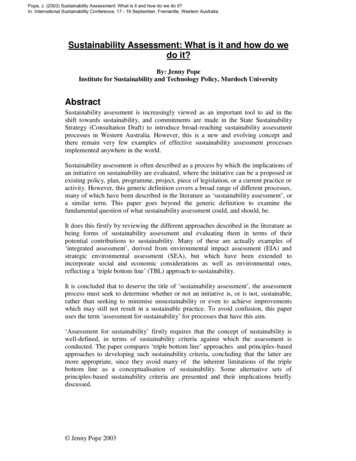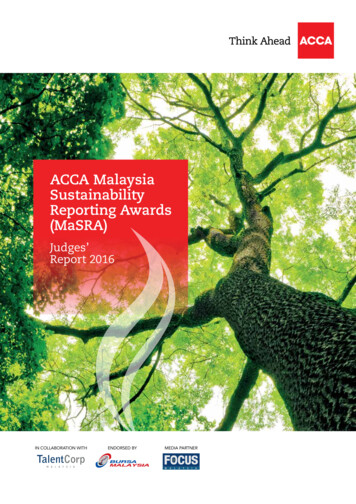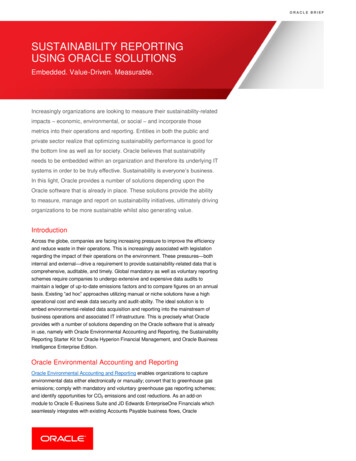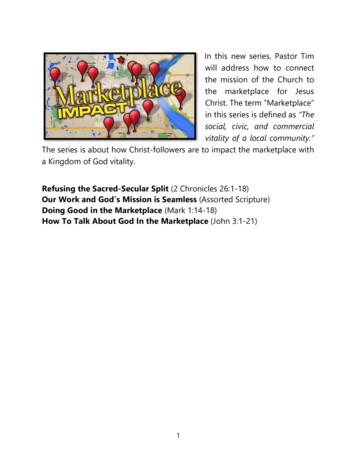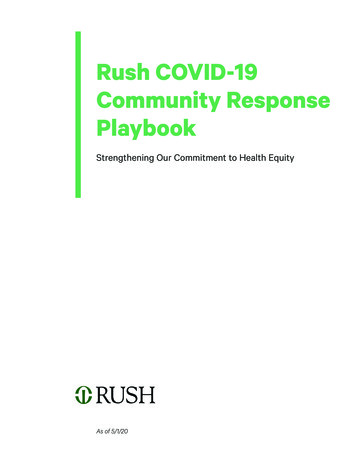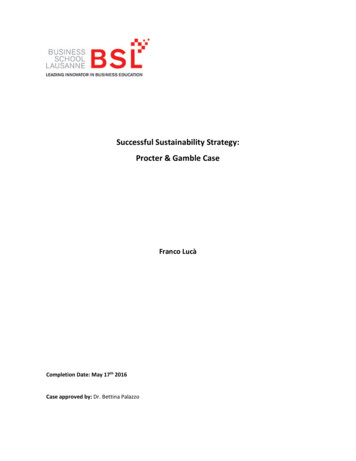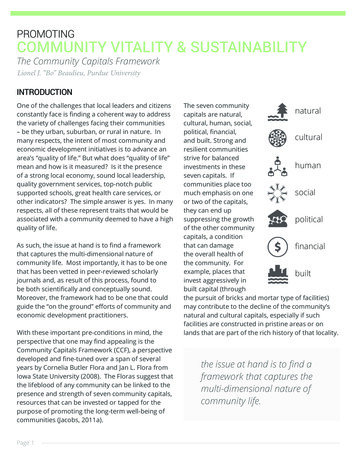
Transcription
PROMOTINGCOMMUNITY VITALITY & SUSTAINABILITYThe Community Capitals FrameworkLionel J. “Bo” Beaulieu, Purdue UniversityINTRODUCTIONOne of the challenges that local leaders and citizensconstantly face is finding a coherent way to addressthe variety of challenges facing their communities– be they urban, suburban, or rural in nature. Inmany respects, the intent of most community andeconomic development initiatives is to advance anarea’s “quality of life.” But what does “quality of life”mean and how is it measured? Is it the presenceof a strong local economy, sound local leadership,quality government services, top-notch publicsupported schools, great health care services, orother indicators? The simple answer is yes. In manyrespects, all of these represent traits that would beassociated with a community deemed to have a highquality of life.As such, the issue at hand is to find a frameworkthat captures the multi-dimensional nature ofcommunity life. Most importantly, it has to be onethat has been vetted in peer-reviewed scholarlyjournals and, as result of this process, found tobe both scientifically and conceptually sound.Moreover, the framework had to be one that couldguide the “on the ground” efforts of community andeconomic development practitioners.With these important pre-conditions in mind, theperspective that one may find appealing is theCommunity Capitals Framework (CCF), a perspectivedeveloped and fine-tuned over a span of severalyears by Cornelia Butler Flora and Jan L. Flora fromIowa State University (2008). The Floras suggest thatthe lifeblood of any community can be linked to thepresence and strength of seven community capitals,resources that can be invested or tapped for thepurpose of promoting the long-term well-being ofcommunities (Jacobs, 2011a).Page 1The seven communitynaturalcapitals are natural,cultural, human, social,political, financial,culturaland built. Strong andresilient communitiesstrive for balancedhumaninvestments in theseseven capitals. Ifcommunities place toosocialmuch emphasis on oneor two of the capitals,they can end upsuppressing the growthpoliticalof the other communitycapitals, a conditionthat can damagefinancialthe overall health ofthe community. Forexample, places thatbuiltinvest aggressively inbuilt capital (throughthe pursuit of bricks and mortar type of facilities)may contribute to the decline of the community’snatural and cultural capitals, especially if suchfacilities are constructed in pristine areas or onlands that are part of the rich history of that locality.the issue at hand is to find aframework that captures themulti-dimensional nature ofcommunity life.
AN OVERVIEW OF THE SEVEN COMMUNITY CAPITALSWe offer the following as a more extensive descripton of each of the seven capitalsNATURAL CAPITALNatural capital refers to “the landscape, air, water,soil, and biodiversity of both plants and animals”(Flora and Flora, 2008) – in other words, ourenvironment. It is also referred to in the literatureas “natural amenities” (McGranahan, 1999) –assets that are linked to a particular place, such asweather, geographic location, natural resources,and natural beauty (Emery and Flora 2006). Sincepeople and the communities of which they area part are embedded in the environment, onecould argue that natural capital undergirds severalof the other capitals. A healthy and functioningenvironment provides valuable ecosystem services,such as food, timber, wildlife habitat, flood control,and recreational opportunities, which are essentialfor human life. Moreover, people and theircommunities are unable to thrive in areas wherenatural capital is neglected and depleted.CULTURAL CAPITALThe concept of culture provides a frame of referencefor understanding the fabric of community life. Thisfabric is often connected by a common language,symbols, gestures, beliefs, values, and resources. Ina classic textbook definition, culture consists of thematerial and nonmaterial aspects of a way of life,which are shared and transmitted among membersof a society (Rogers et al., 1988). Culture is viewedas a “tool kit of symbols, stories, rituals, even theworld-view that shapes individuals” (Swidler,1986)It includes the values and symbols reflected inclothing, music, industry, art, language, and customs.It also encompasses events, materials (paintings,books), festivals, museums, and other activitiesoccurring in communities (Flora and Flora, 2008).Page 2HUMAN CAPITALIn its simplest form, human capital reflects theinvestments that people make in their education, onthe-job training, or health. Such activities translateinto improved knowledge, skills, and health status forindividuals – factors that increase their human capitalstock. As stocks improve, productivity levels increase,resulting in higher earnings for these workers.Human capital also refers to efforts by individuals toenhance their interpersonal and leadership skills inhopes of strengthening their ability to become activecontributing members to the civic health of theircommunities (Flora and Flora, 2008).The benefits of human capital investments are notaccrued solely to individuals. Communities with goodshares of educated, healthy, and skilled workersalso benefit, especially in their capacity to remainresilient during periods of economic uncertainty.Places with a good base of creative/knowledge-basedworkers, for example, tend to experience economicgrowth or stability. Why is that the case? Simply put,creative/knowledge-based workers serve as enginesof innovation and entrepreneurial activities, actionsthat help create a good number of high paying jobs incommunities and regions (Henderson and Abraham,2005; Metcalfe and Ramlogan, 2005; Munnich andSchrock, 2003). Similarly, the expanding interest inSTEM-related occupations (those associated withscience, technology, engineering and mathematics) isdue, in no small measure, to the fact that STEM-relatedjobs have outpaced non-STEM jobs by a factor of 3 to 1in the U.S. over the span of the last decade (Langdon etal., 2011). But, communities that want to gain groundin terms of expanding their creative/knowledge orSTEM-related sectors will be unable do to so withoutthe presence of a sizable pool of workers with stronghuman capital credentials.
AN OVERVIEW OF THE SEVEN COMMUNITY CAPITALSWe offer the following as a more extensive descripton of each of the seven capitalsSOCIAL CAPITALSocial capital represents the “glue” that holds acommunity together and whose presence can spurthe type of economic growth that brings benefitsto the entire community. In communities wheregood things are happening across the spectrum– in education, in job creation, in health care, incommunity services – a broad-based corps of civicminded people and organizations is often in placeto undergird these important activities. Socialcapital consists of “bonding” and “bridging” activitiesthat occur within the local community setting, aswell as “linkages” that tie community membersto organizations and resources located outsidethe community (what is sometimes referred toas vertical connections). Bonding represents thestrong interactions and ties that people have withfamily, friends, neighbors, and close work associates.Bridging reflects the linkages that individuals havewith people and groups within the community withwhom they have only limited interactions or withindividuals and organizations outside of the locality.These types of relationships are what Granovetter(1973) labels as “weak ties” that can be accessed intimes of need.The third element, vertical linkages, offers an avenuefor local people, organizations and communities togain access to valuable resources and ideas fromoutside the community that can be used to supportand guide local initiatives. According to Woolcock(2001), the presence of various combinations ofbonding, bridging, and linking social capital can havepositive impacts on the range of social and economicoutcomes that are possible in communities.Page 3POLITICAL CAPITALThere are several dimensions associated with the conceptof political capital. The first relates to individuals who arein positions of power and influence in the community. AsFlora and Flora (2008:145) note, it is “the ability to affectthe distribution of both public and private resources withinthe community.” A second dimension has to do with theability to gain access to individuals and organizations – theso-called power brokers or movers and shakers -- withthe resources to influence important decisions (Floraet al., 2004). A third aspect of political capital refers toefforts that are made to develop new leadership in thecommunity, and/or expand the engagement of citizensin discussions of important community matters throughthe use of various strategies, such as deliberation forums.By focusing on these various aspects of political capital,we can gain a better understanding of what people andgroups are calling the shots in a community, and whatgroups are having little influence or role in shaping localdecisions (Flora and Flora, 2008).How can you determine the nature of political capitalin your community? A good bit of it requires carefulmonitoring of how and by whom decisions are made in acommunity. For example, drawing upon a rich literatureon community power, we know that when key decisionsare made by only a handful of people, you tend to havean elite leadership structure in place in the community.On the other hand, if decisions tend to be dispersedacross a variety of people and groups, depending on theissue being discussed or debated, then you may havethe presence of a more pluralistic leadership structure(Aiken and Mott, 1970). Other hints of whether influenceis shared or held tightly by a small group of elites is whenyou see (or fail to see) the launching of local leadershipdevelopment programs, community/town-hall meetings,or public deliberation sessions, features of a communitythat suggest that local leaders are open to the involvementof a larger group of people weighing in, and actively takingpart, in tackling important local issues.
AN OVERVIEW OF THE SEVEN COMMUNITY CAPITALSWe offer the following as a more extensive descripton of each of the seven capitalsFINANCIAL CAPITALFinancial capital represents resources neededto fund the provision, construction, andimplementation of a variety of programs,projects, and assets that advance thecommunity’s economic, social, and infrastructuredevelopment. A stable and vibrant communitylife depends on the availability of reliable financialcapital institutions. These include communitydevelopment banks, credit unions, loan funds,venture capital funds, and microenterprise loanfunds. These entities serve as potential sources ofa wide range of products and services, includinghousing, community facilities, small business loans,and other community services that can serve torevitalize economically distressed communities.Their primary role is to bring financial and businessresources to communities in order to stimulateeconomic growth and foster a stable regionaleconomy.The availability of financial capital can contributeto wealth creation and to community economicdevelopment activities, especially in low- tomoderate-income households or communities.Community development financial institutions(CDFIs), for example, can provide a wide rangeof financial products and services for peopleand communities that are often by-passed bytraditional financial institutions. So too, can grantmaking foundations whose activities are intendedto address a wide array of local needs andopportunities.IS THERE A SUBSET OF COMMUNITYCAPITALS THAT SHOULD BE GIVENPRIORITY ATTENTION OVER THEOTHER CAPITALS?Page 4BUILT CAPITALBuilt capital (also referred to as the built environment)is the man-made infrastructure that supports humansociety – our roads, bridges, airports, water treatmentfacilities, buildings (factories, schools, offices, stores),communication technologies, and public places. Thebuilt environment also includes design factors andland uses, i.e., how our neighborhoods, communities,and cities are laid out. The built environment can havea significant impact on an individual’s physical andmental well-being and on community life.CONNECTING THE CAPITALSTHE SPIRALING-UP OF COMMUNITY CAPITALSTable 1 (page 5) provides a synopsis of the sevencapitals, noting how each is defined and examplesof the type of assets that can be linked to each ofthe capitals. Most communities would find it verychallenging to pursue simultaneous investments inthe seven capitals. So, the question is this: “Is therea subset of community capitals that should be givenpriority attention over the other capitals?” The answerdepends on the unique strengths and needs of eachcommunity. In other words, there is no one size fits allwhen it comes to which of the capitals should be givenprecedence over others in any community.What we do know from community studies is thatpursuing positive change in one type of capital cancreate opportunities for improvements in othercommunity capitals (Emery and Flora, 2006). Assumefor a moment that local leaders in a community havereached out to a diversity of people in the community,seeking their input on a new strategic blueprint for thecommunity. The effort to touch base with more peoplehas strengthened communications and dialoguebetween local leaders and residents. In fact, localleaders have decided to meet every three months with
TABLE 1 The Seven Types of Community alBuiltDEFINITIONEXAMPLESThe quality and quantity of natural and environmentalresources existing in a community.Parks; lakes; rivers; wildlife; forestland;farm land; mountains; other naturalresource features.The values, norms, beliefs and traditions that people inheritfrom the family, school and community. Also includes materialgoods produced at a specific time and place (such as paintings,books) that have historical or cultural significance.Cultural events/festivals; musical heritage,libraries; museums; multi-lingualpopulations; historical associations.Attributes of individuals that provide them with the ability toearn a living, strengthen community, and otherwise contributeto community organizations, to their families, and to selfimprovement (Flora et al. 2004). It includes access to educationand knowledge development, training and skill buildingactivities and efforts to build and expand local leadership.Formal and informal educationalinstitutions; workforce training programs;adult and youth leadership programs;lifelong learning activities.Connections existing among people and organizations that helpmake things happen in the community. Includes close ties thatbuild community cohesion (bonding) as well as weaker ties withlocal and outside people and organizations that help promotebroad-based action on key matters (bridging).Activities that build trust among peopleand groups of different races and ethnicbackgrounds; citizen involvement incommunity discussions and events;community celebrations or parades;involvement in civic and service groups;organizations that link diversity of peopleand organizations together.The ability to influence and enforce rules, regulations, andstandards. Access to individuals and groups with the power toinfluence decisions. Participating in civic discourse on difficultpublic issues.Elected and appointed governmentofficials; citizen participation in issueforums; Congressional representativesand staffers; political organization leaders;voting rates in local, state and nationalelections.The variety of financial resources available to invest in localprojects or economic development initiatives. Efforts to buildwealth to support community development activities.Community foundations; grants; microloan programs; revolving loan funds;community development financialinstitutions; banks.Represents the infrastructure of the community – the basicset of facilities, services and physical structures needed by acommunity.Broadband and other informationtechnologies; utilities; water/sewersystems; roads/bridges; business parks/incubator facilities; hospitals/health carebuildings; main street buildings; housingstock.Sources: Flora and Flora (2008); Flora, Flora and Fey (2004); Jacobs (2011a, 2011b, 2011c, 2011d); Flage and Hauser-Lindstrom (2007);Emory, Fey and Flora (2006).Page 5
various neighborhood groups as a way to continueto secure input and feedback from local people.This activity has brought about positive changesin two capitals – political and social. Let’s furtherassume that citizens urged local leaders to helpretain and expand local businesses and to invest innew entrepreneurial ventures so that exciting newinnovations could be seeded in the community.So, the local leaders ended up launching a newbusiness retention/expansion program, focusingon improving the skill levels of business ownerswho were at risk of losing their business, aneffort to improve the human capital skills of theseindividuals. Working with local banks and thecommunity foundation, the local leaders wereable to establish a small loan program designed toinvest in new entrepreneurial ventures. The focuson entrepreneurship helped retain some of its besteducated and creative workers in the community.In addition, the financial capital resources availableto support local economic development activitieswere expanded. This story – which began with theneed to build stronger political and social capital –created positive shifts in the human and financialcapital assets of the community. This scenariohighlights the spiraling up effect that can occurwhen you begin to invest in one of the communitycapitals. That is, when a community works to buildassets in one of the capitals, this fosters the growthof other capital assets.CONCLUDING COMMENTSIn most communities, efforts to develop andsustain a strong, vibrant community are a longterm process. The community capitals frameworkoffers local leaders, organizations and residentsa deeper understanding of the multi-prongedapproach that is needed if communities hopeto create the foundation necessary for them tosurvive and thrive over the long-term. While it mayappear overwhelming to give attention to all sevencommunity capitals, the reality is that communitiesPage 6should start by focusing on a smaller set ofcommunity capitals, and then give attention to theother capitals over time. Before you know it, thespiraling effect noted earlier in this document willbegin to take hold, resulting in visible improvementsin the community.REFERENCESAiken, Michael and Paul E. Mott (editors). 1970.Structure of Community Power. New York: RandomHouse.Emery, M. & Flora, C.B. (2006). Spiraling-Up:Mapping Community Transformation withCommunity Capitals Framework. CommunityDevelopment: Journal of the CommunityDevelopment Society, 37, 19-35 (Spring).Emery, M., S. Fey, and C.B. Flora, 2006. “UsingCommunity Capitals to Build Assets for PositiveCommunity Change.” CD Practice 13. CommunityDevelopment Society. age, Lynette and Doreen Hauser-Lingstrom. 2007.“Connecting citizens to strengthen communities.”Social Capital Training, Northwest Area Foundation(December).Flora, C.B., Flora, J.L. and Fey, S. 2004. RuralCommunities: Legacy and Change (2nd Edition).Boulder, CO: Westview Press.Flora, C.B. & Flora, J.L. (2008). Rural Communities:Legacy and Change (3rd Edition). Boulder, CO:Westview Press.Granovetter, M. 1973. “The strength of weak ties.”American Journal of Sociology, 78: 1360-1383.Jacobs, C. 2011a. “Measuring success incommunities: Understanding the communitycapitals framework.” Extension Extra. South DakotaState Cooperative Extension Service: Issue 16005(Revised April).
REFERENCES continuedJacobs, C. 2011b. “Community capitals: Naturalcapital.” Extension Extra. South Dakota StateCooperative Extension Service: Issue 16006 (RevisedApril).Rogers, E.M., Burdge, R.J., Korsching, P.F. andDonnermeyer, J.F. 1988. Social Change in RuralSocieties: An Introduction to Rural Sociology.Englewood Cliffs, NJ: Prentice Hall.Jacobs, C. 2011c. “Community capitals: Culturalcapital.” Extension Extra. South Dakota StateCooperative Extension Service: Issue 16007 (RevisedApril).Swidler, A. 1986. “Culture in action: Symbols andstrategies.” American Sociological Review; 51:273286.Jacobs, C. 2011d. “Community capitals: Humancapital.” Extension Extra. South Dakota StateCooperative Extension Service: Issue 16008 (RevisedApril).Henderson, Jason and Bridget Abraham. 2005.“Rural America’s emerging knowledge economy.”The Main Street Economist, Center for theStudy of Rural America, available at treet/MSE 0505.pdfLangdon, D., McKittrick, G., Beede, D., Khan, B. andDoms, M. 2011. STEM: Good Jobs Now and for theFuture. U.S. Department of Commerce, Office of theChief Economist. ESA Issue Brief #03-11 (July).McGranahan, D.A. 1999. “Natural amenities driverural population change.” Agricultural EconomicReport No. 781, Economic Research Service, USDA(October). fe, J.S. and Ramlogan, R. 2005. “Limits tothe economy of knowledge and knowledge of theeconomy.” Future, 37 (September).Munnich, L.W. Jr. and Schrock, G. 2003. “Ruralknowledge clusters.” Chapter 8 in Norman Walzer(ed.), The American Midwest: Managing Change inRural Transition. Armonk, New York: M.E. Sharpe.Page 7Woolcock, Michael. 2001. “The place of socialcapital in understanding social and economicoutcomes.” Canadian Journal of Policy Research(Spring): 11-17.CONTACTLionel J. “Bo” BeaulieuPurdue Universityljb@purdue.edu(765)494-7273
clothing, music, industry, art, language, and customs. It also encompasses events, materials (paintings, books), festivals, museums, and other activities occurring in communities (Flora and Flora, 2008). CULTURAL CAPITAL In its simplest form, human capital reflects the investments that people make in their education, on-the-job training, or health.



